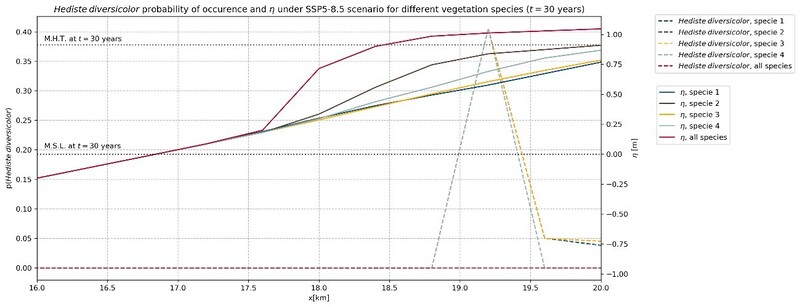J.G. Tobal Cupul1,2*, N. Tambroni2 , V. Asnaghi2
1 Wageningen University and Research, The Netherlands; 2 University of Genoa, Italy
* Corresponding author: jessica.tobalcupul@wur.nl
Introduction
Salt marsh ecosystems are highly dynamic environments that offer a range of ecosystem services, including coastal protection, climate regulation, and biodiversity support. Nevertheless, these ecosystems are increasingly vulnerable to both natural and anthropogenic pressures. To effectively restore and manage salt marshes, it is crucial to understand the complex interplay between ecological and morphodynamic processes.
Globally, there has been an interest in macrozoobenthos (invertebrates that inhabit seabed environments as the intertidal zone), because they are used as key indicators of environmental health in salt marshes due to their sensitivity to changes in water quality, sediment conditions, habitat structure and their played role in the functioning of salt marsh ecosystems.
In the case of Venice Lagoon (VL), various 1-D and 2-D models have been developed to simulate the ecological and morphodynamic processes of salt marshes. However, they have specially focused on only the interaction between salt marsh vegetation and its hydro-morphodynamics.
Objective and Methods
The aim was to determine macrozoobenthos species presence in a salt marsh in the VL by analyzing key ecomorphodynamic processes driving long-term marsh evolution through a one-dimensional mode. We built on Tambroni and Seminara (2012) idealized 1-D model for VL to incorporate Total Organic Carbon (TOC), and macrozoobenthos presence.
The model consists of different parts, the hydrodynamic submodule calculates flow field due to a tidal forcing, the morphodynamic module assesses sediment flux and deposition (inorganic and organic), while the vegetation module models plant growth/decay based on local hydrodynamic conditions. Finally, TOC content is calculated as a function of vegetation, and the macrozoobenthos submodule evaluates species presence based on local water depth and TOC thresholds.
We consider four vegetation species (Spartina, Sarcocornia, Limonium, and Juncus) and five macrozoobenthos species (Abra alba, Capitella capitata, Cerastoderma glaucum, Hediste diversicolor, and Heteromorfos filiformis). Historical data from 94 stations were used to determine macrozoobenthos dominance over TOC thresholds using Indicator Species Analysis.
Simulations over 140 years explored sea level rise (SLR) impacts under IPCC scenarios SSP3-7.0 and SSP5-8.5, compared to a no-rise scenario, providing insights into marsh evolution and species dynamics.
Results
The enhanced 1-D model predicted the marsh evolution and the presence of macrozoobenthos in VL, particularly Capitella capitata, Cerastoderma glaucum, and Hediste diversicolor, considering their dominance for different TOC levels.
Vegetation is found to mitigate the impact of SLR, even when elevated sea levels inhibited vegetation growth. At the end of the 140-year simulations under the SSP5-8.5 SLR scenario the salt marsh retreated and drowned for different vegetation species. However, early growth during the first 30-40 years helped marshes withstand SLR, particularly in the multi-vegetation scenario. Similar results were found for SSP3-7.0 scenario.
Figure 1 shows the presence of Hediste diversicolor which reaches peak after the first 30 years of simulation but disappears after 140 years in the SSP5-8.5 scenario due to the vegetation-dependent nature of TOC. Further research for TOC sources is required to refine the macrozoobenthos presence.

Figure 3. Probability of occurrence of Hediste diversicolor along the marsh at the end of 30-years simulation (SSP5-8.5) using bed elevation (η) of different vegetation scenarios as reference.
References
Tambroni, N. and Seminara, G. (2012) A one-dimensional eco-geomorphic model of marsh response to sea level rise: Wind effects, dynamics of the marsh border and equilibrium. Journal of Geophysical Research: Earth Surface, 117,F03026










